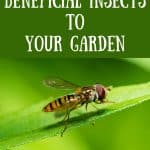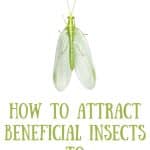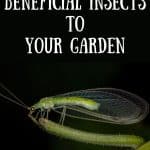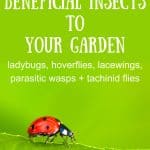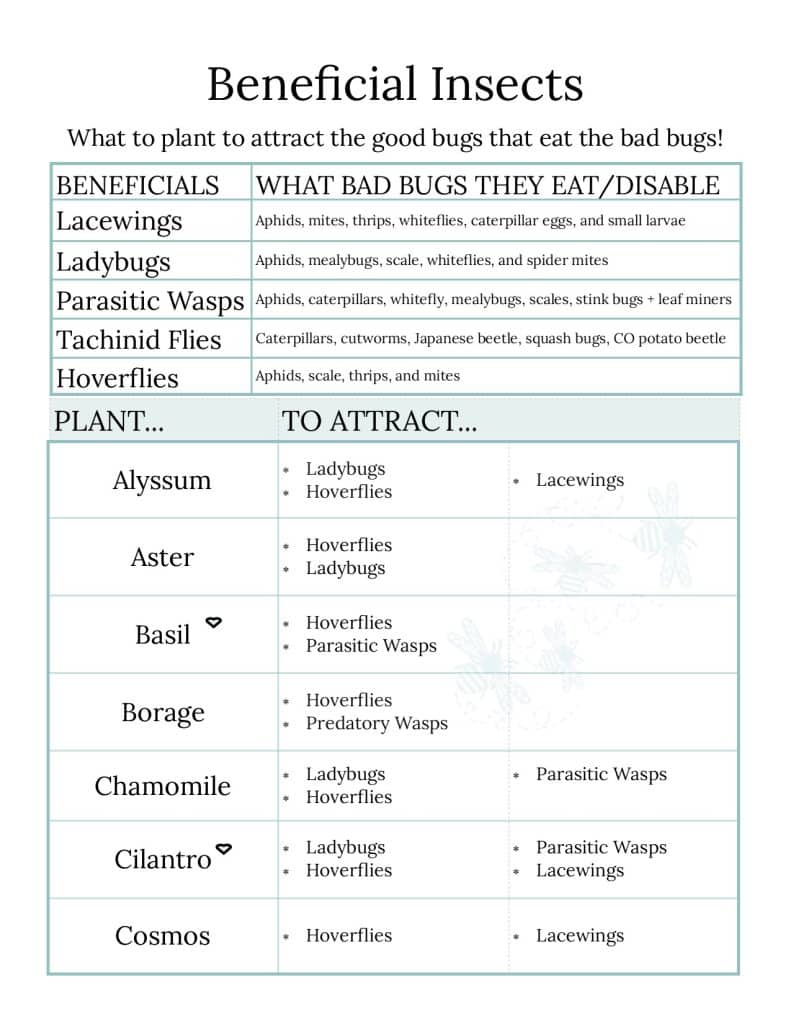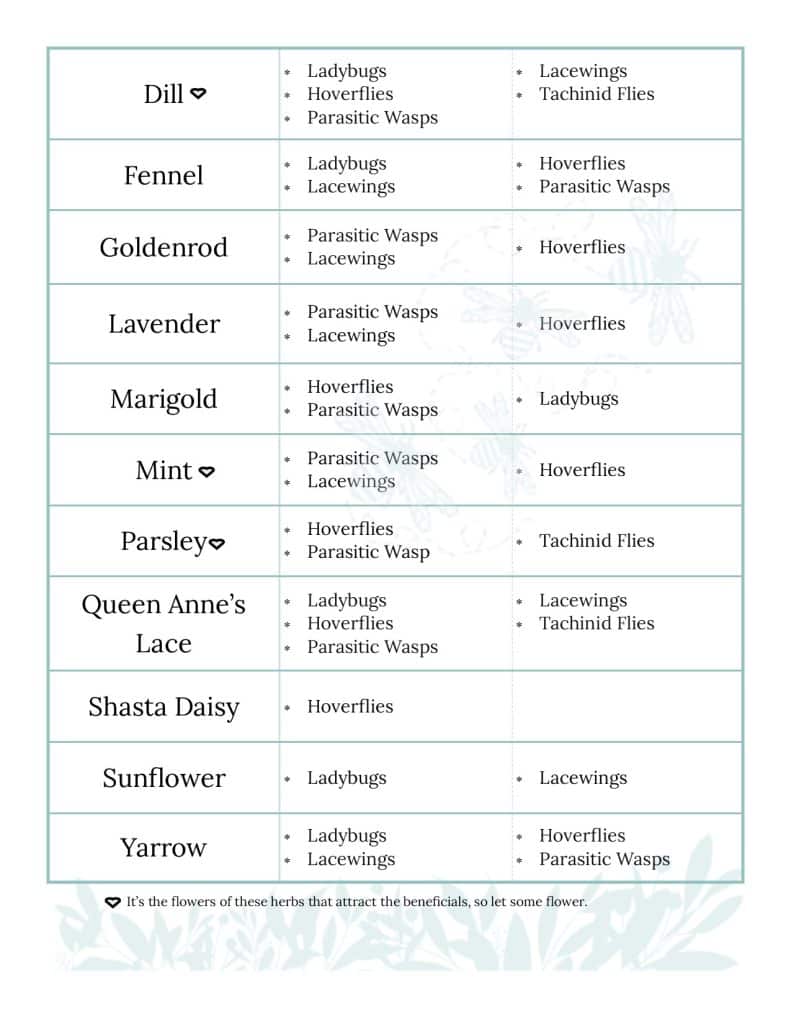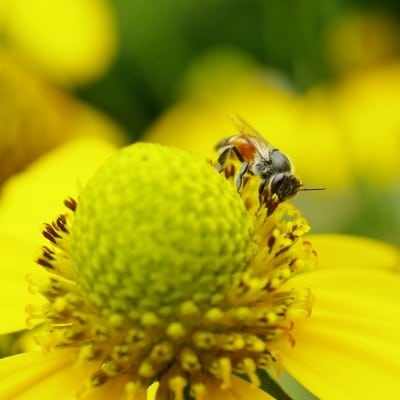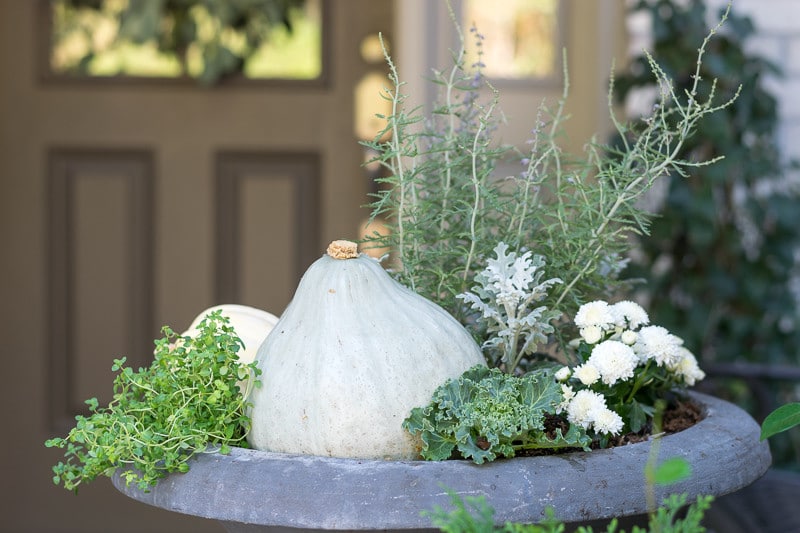Beneficial Insects in The Garden
This post discusses what beneficial insects are, why you want them in your garden, and how to attract them to your garden.
In our neverending quest to garden organically, one of the tools we rely upon is our beneficial insect friends’ help and hard work. Instead of relying on chemicals to combat aphids, we would much rather invite an army of ladybugs to let them snack on the nasty critters.
Instead of spraying for worms, I’d prefer to let parasitic wasps use them as hosts for their egg incubators, simultaneously killing the worms and growing the parasitic wasp population.
And a healthy harvest of cucumbers and zucchini depends almost entirely on the number of worker bees in my garden.
In my humble opinion, not only have we been bug-shy for too long, but we have relied upon harmful chemicals to keep our world bug-free. Continuing to do so harms the balance that nature created eons ago. It’s time to embrace the good bugs as nature intended.

Table of Contents
What Are Beneficial Insects?
Beneficial insects are categorized into predators, pollinators, and parasitoids.
- Predators: Insects, such as ladybugs, lacewings, and certain types of beetles and wasps, help control pest populations by feeding on them. For example, ladybugs consume aphids, a common pest, thus preventing these pests from damaging plants.
- Pollinators: This group includes insects like bees, butterflies, moths, beetles, and flies. Pollinators are crucial for reproducing many plants, including many crops and wild plants, by transferring pollen from one flower to another, facilitating fertilization.
- Parasitoids: Parasitic wasps are a prime example of this group. They lay their eggs on or in the bodies of pest insects. When the eggs hatch, the larvae feed on the host insect, eventually killing it. This natural pest control is especially beneficial in agricultural and garden settings.
What Are Some Beneficial Insects?
Predators
Some common beneficial insect predators include:
- Ladybugs: Ladybugs, also known as lady beetles or ladybird beetles, are undoubtedly one of the most beneficial insects in the garden. They are celebrated for their insatiable appetite for aphids. An adult ladybug can consume an impressive 50 to 60 aphids per day, while their larvae can devour hundreds of aphids per day as they grow. Ladybugs are also known to feed on mealybugs, scale, whiteflies, and spider mites, making them an important ally in the fight against garden pests.
- Ladybug Larva
- Lacewings: Lacewings are a group of beneficial insects known for their delicate, green, or brown wings that resemble lace, hence their name. Lacewing larvae are known as “aphid lions” for their fierce appetites, primarily feeding on a wide range of soft-bodied pests such as aphids, mites, thrips, whiteflies, caterpillar eggs, and other small larvae.
- Lacewing Larva eating an aphid.
- Parasitic Wasps: “Parasitic wasps” is an umbrella term that refers to various types, such as Braconid, Trichogramma, and Ichneumon wasps. They often go unnoticed since they focus primarily on finding host insects to lay their eggs; they are usually small and don’t exhibit aggressive behavior toward humans. Unlike their more noticeable relatives, such as yellowjackets or hornets, parasitic wasps aren’t attracted to human food sources or activities. There are over one million different parasitic wasps, each of whom will target a specific host. Some of the harmful hosts that parasitic wasps will lay their eggs on and in include caterpillars (yes, even butterfly caterpillars 😢), aphids, scale, leafminers, beetles, and spider mites. Braconids are my favorite as they lay their eggs in tomato hornworms, ultimately killing them. If you are lucky enough to spy a caterpillar or other bug with loads of white eggs on it, let it be! You’ll soon have even more helpful parasitic wasps!
- Tomato Hornworm with Parasitic Wasp eggs.
- Tachinid Flies: This beneficial insect is similar to parasitic wasps as they lay their eggs in harmful pests, killing them. At last count, there are more than 8,000 different types of tachinid flies, which look similar to common houseflies but are characterized by bristles on their bums. Another way to distinguish tachinids from nuisance houseflies is that tachinids will most likely be visiting flowers in your garden for nectar, while common houseflies will be…in the trash. Some harmful hosts that tachinid flies will lay their eggs on or nearby include caterpillars (yes, even butterfly caterpillars 😢), Japanese beetles, cucumber beetles, and squash bugs.

Pollinators
Some of the most common pollinators are:
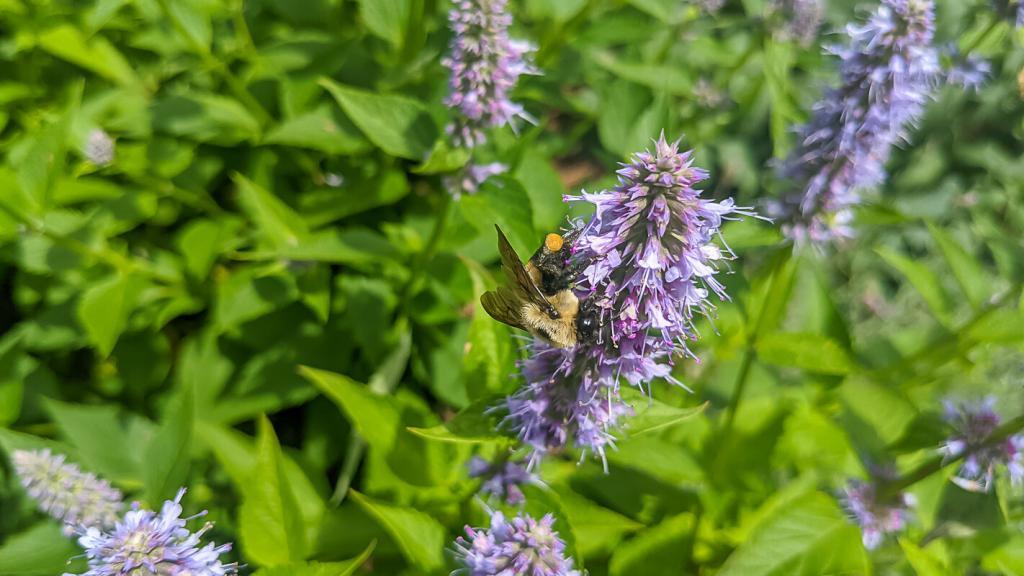
- Bees: Perhaps the most well-known pollinators, Honeybees are essential for pollinating many crops and wild plants. Bumblebees are known for their ability to “buzz pollinate.” They are particularly effective at pollinating tomatoes, peppers, and eggplants, among other crops.
- Butterflies and Moths: The long proboscis of butterflies allows them to reach nectar in deep flowers, and while feeding, they transfer pollen between plants. Monarchs, swallowtails, and skippers are just a few examples. Moths are key pollinators for some plants that bloom at night or early in the morning.
- Birds: Hummingbirds are the primary bird pollinators in North America. Their hovering feeding behavior and preference for brightly colored, tubular flowers make them important pollinators for certain species.
- Bats are crucial for pollinating primarily night-blooming flowers in desert and tropical climates, such as Agave and Saguaro cacti.
- Beetles: You may be surprised to learn that beetles are pollinators! Their pollinating skills primarily benefit magnolia and water lilies.
- Flies: The pesky housefly is a useful pollinator! Who knew!? Some plants mimic the appearance or scent of meat to attract scavenging flies for pollination.
What Damaging Pests Can You Control With Beneficial Insects
| Aphids Controlled by: Ladybugs, lacewings, and parasitic wasps. | Spider Mites Controlled by: Predatory mites, ladybugs, and lacewings. | Whiteflies Controlled by: Ladybugs, lacewings, and parasitic wasps. |
| Caterpillars Controlled by: Braconid wasps, trichogramma wasps, and birds. | Mealybugs Controlled by: Ladybugs and lacewings | Scale Insects Controlled by: Ladybugs, lacewings, and parasitic wasps. |
| Squash Bugs Controlled by: Tachinid flies and predatory bugs. | Slugs and Snails Controlled by: Ground beetles and toads. | Thrips Controlled by: Lacewings, ladybugs, and predatory mites. |
| Leafhoppers Controlled by: Lacewings, ladybugs, and predatory wasps. | Colorado Potato Beetles Controlled by: Ladybugs, lacewings and ground beetles | Japanese Beetles Controlled by: Tachinid flies |
How To Attract Beneficial Insects To Your Garden
Encouraging beneficial insects in your garden helps control destructive pests and adds to the beauty of your outdoor space.
Plant a Variety of Herbs and Flowers
Plant a wide range of flowering plants, including annuals, perennials, herbs, vegetables, and shrubs, to provide nectar and pollen throughout the growing season. My cutting garden that I use to grow and provide freshly cut flowers around our home is a perfect environment. Consider plants like lavender, marigold, sunflowers, zinnias, and native wildflowers. Herbs, when let to flower (e.g., dill, fennel, cilantro), and vegetables (e.g., squash, tomatoes) also attract beneficial insects. At the end of the winter, let your kale and arugula flower. The bees and other pollinators will greatly appreciate it!
For example, the lacewing is attracted to and feeds on the nectar and pollen of herb flowers (dill, cilantro, parsley, etc…) and is more likely to lay its eggs on or near those flowering plants. While lacewings do consume pests like aphids, it is their larvae that do the most!
Consider planting native species when possible, as they provide the best food sources and habitat for local beneficial insect populations. The attached chart shows that many of the flowers and herbs left to flower are referred to as umbellifers, which have umbrella-shaped flowers comprised of many different flower stems. These flowers produce pollen and nectar that sustains many beneficial insects.

Familiarize yourself with plants that attract bees. I’ve written an entire article about those busy workers and what flowers attract bees.
Habitats
To support a healthy environment, it’s important to consider the needs of the creatures that inhabit your garden. Keeping some areas of your garden undisturbed can offer nesting sites for ground-nesting bees and safe spaces for predators like ladybugs to overwinter.
You can install insect hotels for solitary bees and other insects to provide additional nesting opportunities. Here’s how to build an insect hotel.
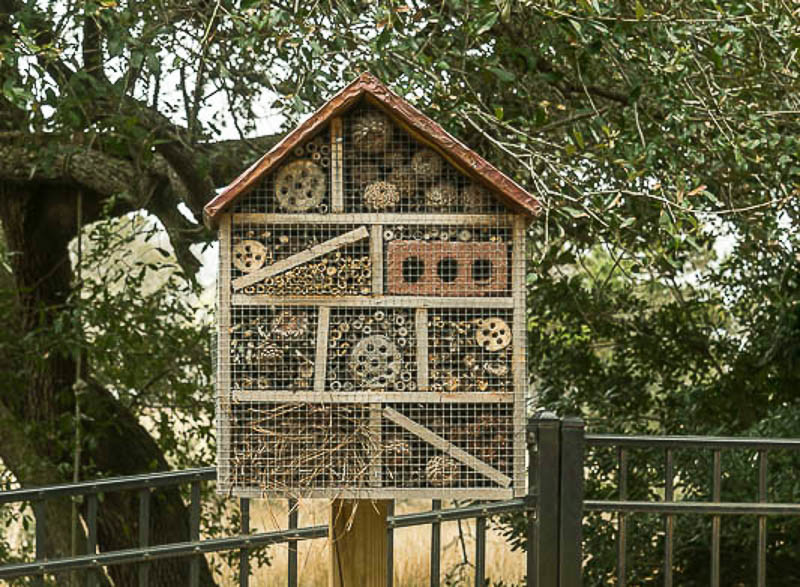
Birdhouses and bat boxes can also invite beneficial insects to your garden. Ponds and water features are also excellent for encouraging and providing housing for frogs and toads. Finally, dead wood and leaf piles can create habitats for beetles, spiders, and other beneficial insects.
Water Sources
Fill shallow dishes or bird baths with stones, marbles, and water to allow insects to drink without drowning. Place damp sponges in protected areas as a water source for butterflies and bees.
Minimize the Use of Chemicals
If you must use pesticides, choose organic options and be careful when applying them to minimize the impact on beneficial insects. Even if you are using organic options, applying them when beneficial insects are less active, early morning or late evening is best. Employ strategies to reduce pest populations with the least environmental impact, such as manually removing pests, barriers, and traps. The last thing you want is to kill the beneficial insects you are working so hard to attract!
Mulch and Ground Covers
Mulches help maintain soil moisture and temperature, benefiting insects and the plants they rely on. Ground covers provide hiding spots for predatory insects, like beetles and spiders.
What Plants Attract Beneficial Insects?
Get a free, two-page printable chart of plants that attract beneficial insects. It is free for all subscribers in the Library. If you’ve forgotten it, the password is at the bottom of the email. If you aren’t a subscriber, what are you waiting for? There is no cost associated with subscribing; you can access all our printables and patterns. Click here if you want to join and have this handy two-page printable sent directly to your inbox. Even if you are a subscriber, you can click to have the printable sent to your inbox.
Frequently Asked Questions Attracting Beneficial Insects
While beneficial insects significantly reduce pest populations, they rarely eliminate them entirely. The goal is to maintain a balanced ecosystem where pests are manageable.
Research is key. Familiarize yourself with the appearance of beneficial insects in your region. Generally, an insect that pollinates plants or preys on known pests is likely beneficial.
This is a natural part of the ecosystem’s balance. Predatory insects may sometimes eat each other, but they usually do not significantly harm the populations of other beneficial insects. Diversity in the garden helps ensure no single beneficial insect population is decimated.
While purchasing beneficial insects can boost your garden’s ecosystem immediately, creating an environment that naturally attracts and supports these insects is more sustainable. Purchased insects often don’t stay where they’re released unless the habitat is suitable.
Provide shallow water sources with stones or sticks for insects to land on safely. A simple birdbath, shallow dish, or even a dripping hose can offer adequate water for beneficial insects.
More Organic Gardening Information
Interested in expanding your knowledge of organic gardening? Check out these posts for information that may be helpful on your organic gardening journey.
- This post discusses companion planting, its benefits, and why you should incorporate it into your garden plans this year. Download and print the Companion Planting Chart for easy reference throughout the gardening season.
- This post discusses the advantages and disadvantages of raised bed vegetable gardening, the best vegetables for raised bed gardens, what vegetables to grow each season in your raised beds, and different types of raised garden beds.
- How to make compost, its benefits, and what you can put in your compost bin.
- All about compost tea.
- How to amend your soil with eggshells.
Bookmark this page or pin the following image to refer back to this post, which describes how to Attract Beneficial Insects to Your Garden.
Thanks so much for spending a few minutes of your busy day with me!
To ensure you don’t miss future content, pop your email in the pale green box on the right or click here. I usually send one email weekly, so I won’t inundate your inbox. I’m sensitive to an overflowing email inbox!
We will only use your email address to send you emails, no more than 1-2 weekly. In addition, you will have access to my growing library of knit & crochet patterns and other printables. Check back often as this library will continue to grow. You can unsubscribe anytime by emailing me or clicking on the “unsubscribe” link at the bottom of all emails.
And you can access many of the products I refer to on my Nourish and Nestle Amazon Page. You can access it here.
So, if you’d like to participate in the ‘subscriber benefit’ action, simply subscribe to Nourish and Nestle here or use the form on the right sidebar. It’s slightly towards the top.
I have sent all my subscribers the link to the Subscriber Benefits Library. If you missed it or misplaced it, let me know.
Until next time…


